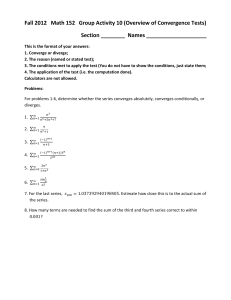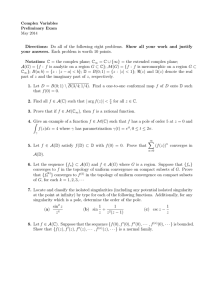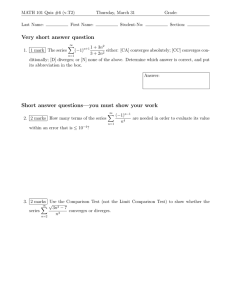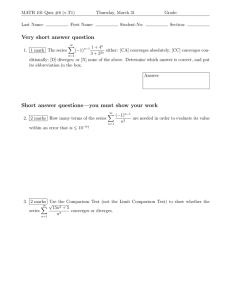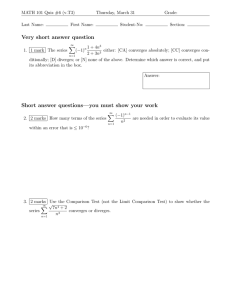Math 539 Comments on Homework #4 G
advertisement
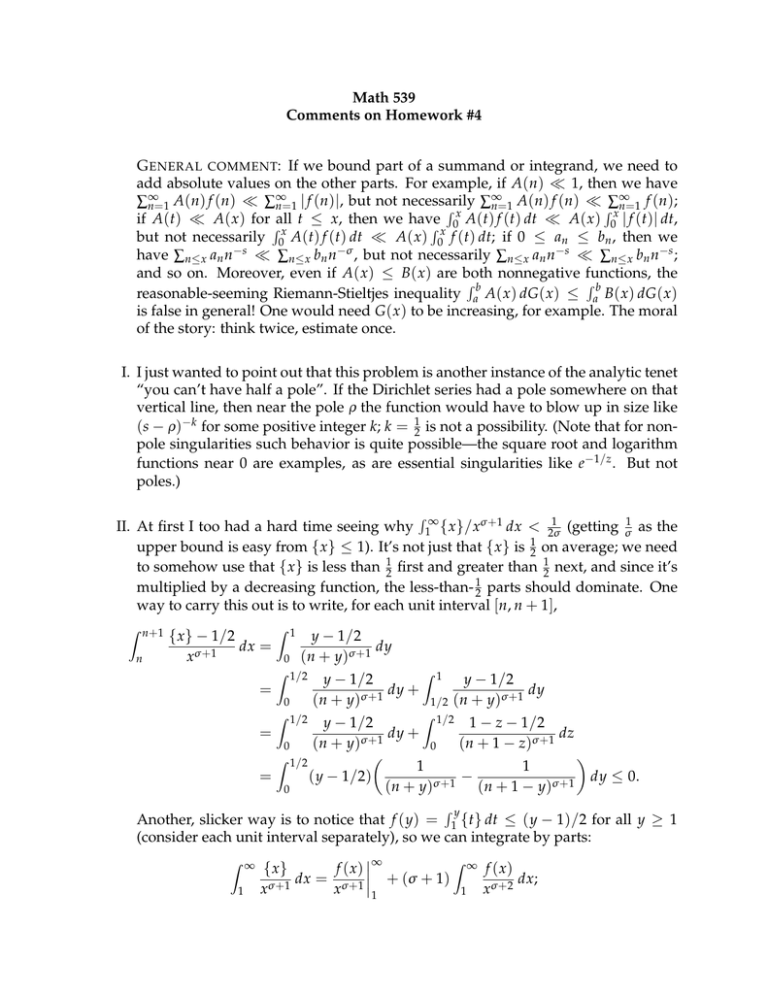
Math 539
Comments on Homework #4
G ENERAL COMMENT: If we bound part of a summand or integrand, we need to
add absolute values on the other parts. For example, if A(n) 1, then we have
∞
∞
A(n) f (n) R∑∞
∑∞
n=1 A ( n ) f ( n ) ∑n=1 | f ( n )|, but not necessarily
n = 1 f ( n );
R x ∑n=1
x
if A(t) A( x) for Rall t ≤ x, then we have
A
(
t
)
f
(
t
)
dt
A
(
x
)
0 | f ( t )| dt,
Rx 0
x
but not necessarily 0 A(t) f (t) dt A( x) 0 f (t) dt; if 0 ≤ an ≤ bn , then we
have ∑n≤x an n−s ∑n≤x bn n−σ , but not necessarily ∑n≤x an n−s ∑n≤x bn n−s ;
and so on. Moreover, even if A( x) ≤ B( x) are both nonnegative functions, the
R
R
reasonable-seeming Riemann-Stieltjes inequality ab A( x) dG ( x) ≤ ab B( x) dG ( x)
is false in general! One would need G ( x) to be increasing, for example. The moral
of the story: think twice, estimate once.
I. I just wanted to point out that this problem is another instance of the analytic tenet
“you can’t have half a pole”. If the Dirichlet series had a pole somewhere on that
vertical line, then near the pole ρ the function would have to blow up in size like
(s − ρ)−k for some positive integer k; k = 12 is not a possibility. (Note that for nonpole singularities such behavior is quite possible—the square root and logarithm
functions near 0 are examples, as are essential singularities like e−1/ z . But not
poles.)
1
II. At first I too had a hard time seeing why 1∞ { x}/ xσ +1 dx < 2σ
(getting σ1 as the
upper bound is easy from { x} ≤ 1). It’s not just that { x} is 12 on average; we need
to somehow use that { x} is less than 12 first and greater than 21 next, and since it’s
multiplied by a decreasing function, the less-than- 12 parts should dominate. One
way to carry this out is to write, for each unit interval [n, n + 1],
R
Z n+1
{ x} − 1/2
n
xσ +1
dx =
=
Z 1
0
y − 1/2
dy
(n + y)σ +1
Z 1/2
0
Z 1/2
y − 1/2
dy +
(n + y)σ +1
Z 1
1/2
y − 1/2
dy
(n + y)σ +1
Z 1/2
y − 1/2
1 − z − 1/2
dy +
dz
σ
+
1
(n + y)
(n + 1 − z)σ +1
0
0
Z 1/2
1
1
=
( y − 1/2)
−
dy ≤ 0.
(n + y)σ +1 (n + 1 − y)σ +1
0
=
Ry
Another, slicker way is to notice that f ( y) = 1 {t} dt ≤ ( y − 1)/2 for all y ≥ 1
(consider each unit interval separately), so we can integrate by parts:
∞
Z ∞
Z ∞
{ x}
f ( x) f ( x)
dx = σ +1 + (σ + 1)
dx;
σ
+
1
σ +2
x
1 x
1 x
1
the boundary terms are both 0, and the new integrand is nonnegative and
(σ + 1)
Z ∞
f ( x)
1
xσ +2
∞ ( x − 1 )/ 2
dx ≤ (σ + 1)
dx
xσ +2
1
∞
σ +1
1
1
=
− σ+
2
σx
(σ + 1) xσ +1 1
1
1
σ +1 1
−
=
.
=
2
σ σ +1
2σ
Z
The moral of this story: to take advantage of cancellation, put the sum/integral
that has the cancellation in the innermost position. Summation/integration by
parts often accomplishes this.
V. It might seem that the most natural way to do this problem is to prove that for all
σ ≤ 0, the series A(σ ) converges if and only if R( x) xσ , but this equivalence is
false. As it happens, the convergence of A(σ ) does imply that R( x) = o( xσ ) even;
however, R( x) xα implies only that A(α + ε) converges for every ε > 0, but not
necessarily that A(α ) itself converges. Fortunately, the abscissa of convergence
and the quantity described in the question are both infema, and so we only have
to show that
A(σ + ε) converges for every ε > 0
⇐⇒
R( x) xσ +ε for every ε > 0.
(Technical note: according to the definition of infemum, we don’t need the above
statements for every ε > 0, but only for a sequence of ε tending to 0 from above.
Fortunately, however, if A(σ0 ) converges then A(σ ) converges for every σ > σ0 ,
and similarly for upper bounds for R( x); therefore we don’t have to speak in terms
of sequences of ε—either it works for all ε > 0 or it stops working below some
threshhold ε.)
VI. Many of you experimented with the tables of values of σ (n)2 and σ (n2 ) and related
multiplicative functions on prime powers, finding by hand convolution identities
that eventually reduced the problem to recognizing familiar Euler products. This
is a perfectly reasonable approach. I did want to remind you that there is a more
“mindless” approach, namely simply to compute the Bell series for these functions. For example, looking at σ (n)2 :
2
∞
∞ k+1
p
−1
k 2 k
B p ( x) = ∑ σ ( p ) x = ∑
xk
p
−
1
k=0
k=0
=
1
( p − 1)2
∞
∑
p2k+2 − 2pk+1 + 1 xk
k=0
p2
2p
1
−
+
2
1 − p x 1 − px 1 − x
1 + px
= ··· =
(1 − x)(1 − px)(1 − p2 x)
1
=
( p − 1)2
after a lot of algebra. Therefore the factor corresponding to p in the Euler product
2 −s is
of ∑∞
n=1 σ ( n ) n
B p ( p−s ) =
1 − p2−2s
1 + p1−s
=
,
(1 − p−s )(1 − p1−s )(1 − p2−s )
(1 − p−s )(1 − p1−s )2 (1 − p2−s )
whence
∞
∑
n=1
σ ( n )2 n−s =
∏ B p ( p−s ) =
p
1 − p2−2s
ζ (s)ζ (s − 1)2ζ (s − 2)
=
.
∏ (1 − p−s )(1 − p1−s )2 (1 − p2−s )
ζ (2s − 2)
p
VII. Most of you gave the solution I had in mind, namely showing that η(s) + ζ (s + α )
had σc = 1 − α and σ a = 1. However, the argument that σ a = 1 (for example)
n−1 + n−α n−s converges
was flawed in some solutions. Showing that ∑∞
n=1 (−1 )
absolutely for σ > 1 does not prove that σ a = 1, but only that σ a ≤ 1. In general,
the mistake boils down to claiming that σ a ( f + g) = max{σ a ( f ), σ a ( g)} rather
than the accurate σ a ( f + g) ≤ max{σ a ( f ), σ a ( g)}. Note that the equality is provably true (I believe) if σ a ( f ) 6= σ a ( g), but certainly not in general: f + g might be
constant, for example.
VIII(b). Several of you went through a full inductive derivation parallel to the solution of
part (a), but one can reduce this case directly to the result in part (a) as follows.
Suppose that C and d are chosen so that | f (n)| ≤ Cnd ; then it can be checked that
the function
f (n) −d− log(Clog/| f2(1)|)
g(n) =
n
f (1)
satisfies g(1) = 1 and | g(n)| ≤ 1 for all n ∈ N. (This is just a specific way of increasing the d enough to overcome the unwanted constant C; increasing it enough
so that the inequality holds for n = 2 is the worst case.) Part (a) shows that g−1 (n)
is of polynomial growth, and it follows easily that f −1 (n) is then of polynomial
growth, since the convolution inverse of λ f (n)nk is λ −1 f −1 (n)nk .
VIII(c). The point here is that an arithmetic function f (n) having polynomial growth is
−s converging in some half-plane (that
equivalent to the Dirichlet series ∑∞
n=1 f ( n ) n
is, having σc < ∞): polynomial growth implies convergence for large σ by com−p
parison to the sum ∑∞
n=1 n , while convergence for some s implies the growth
σ
bound f (n) n since the terms in a convergent series must tend to 0.

